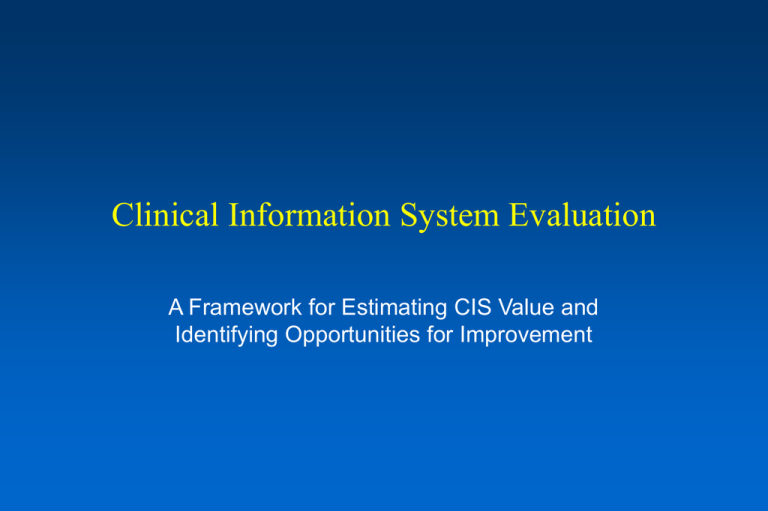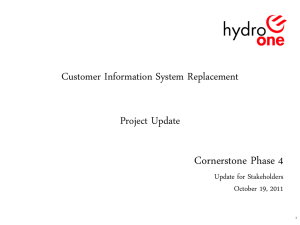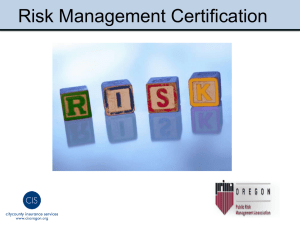Clinical Information System Evaluation Framework
advertisement

Clinical Information System Evaluation A Framework for Estimating CIS Value and Identifying Opportunities for Improvement Why Evaluate? Three purposes of the evaluation process: 1. To compare the results with the goals and expected effects of the system 2. To direct work towards the expected result with the help of evaluation during the development of the system 3. To use the findings and outcomes as an experience base for the next project (Peterson & Jelger, 1988) Clinical Information System Evaluation Framework Does IT make a difference? Literature Review • The earliest studies were done at the Regenstrief Institute in the late 1970s, evaluating the effectiveness of CIS on adherence to influenza vaccination. Since then, there have been hundreds of articles seeking to evaluate CIS in various domains: quality, efficiency, and costs. • Neumann, Parente, and Paramore (1996) reviewed eleven studies and presented a consolidated analysis of each. They found that fully automating administrative functions could save between $5 and $8 billion annually. • The “Most Wired” report (Solovy, 2001) by Hospital and Health Networks and Deloitte Consulting shows that “most wired” hospitals have better control of expenses and higher productivity. Clinical Information System Evaluation Framework Does IT make a difference? Literature Review • Chaudhry et al. conducted a systematic review on 257 articles evaluating health information technology. – – – – – Quality improvement: increased adherence to guidelines, enhanced disease surveillance, and decreased medication errors. Major efficiency benefit: decreased utilization of care Effect on time utilization is mixed Empirically measured cost data is limited and inconclusive Major limitation of the literature is its generalizability Chaudhry B, Ann Intern Med. 2006;144:E-12-E-22. Two Approaches to CIS Evaluation Objectivist Approach Quantitative Important system attributes that can be measured and interpreted Subjectivist Approach Qualitative Observation results are dependent on context and observer; different individuals or groups may hold a different opinion about a systems value (Burkle et. Al, 2001) Two Approaches to CIS Evaluation Objective Approach Has seldom produced positive evaluation results when applied to complex clinical information systems – Consumed large amounts of resources – Expected and measured objective parameters, such as time saving, did not exceed those of the control Subjective Approach Very often, the influence of such a system will not manifest in direct time savings, but in: – Improved cooperation between departments – Increased quality of documentation – Better patient care (Burkle et. al, 2001) Objectives of the CIS Evaluation Framework Internal • To provide a method for assessing CIS systems in order to quantify value and identify opportunities for improvement External • To contribute to the broader healthcare community by designing a generalizable methodology for value-rating CIS system technologies in order to facilitate decisions on technology implementations Clinical Information System Evaluation Framework Is the CIS used? Does it make a difference? Extent of technology facilitation of outcomes ? Benefits Realization Number Individual projects can be evaluated comparatively for benefit realization • Quantifies the benefits of the Clinical Information System • Based on three questions: – – – • Is the CIS being used? Does it make a difference in quality of care, clinician workflow, or business decision making? Is the change related to the technology implemented? Ranking value product of 3 numbers multiplied (highest 27) – – – Use 1-3 Difference 1-3 Sharing 1-3 Ranking Scheme – Benefits Realization Rank Population Outcomes CIS contribution to outcomes 1 Limited use impacting < 25% of population No harm averted, minor efficiency or cost savings achieved Small CIS contribution 2 Moderate use impacting 50% of population Minor harm averted, moderate efficiency or cost efficiency CIS plus other approaches 3 Maximum use impacting 95 - 100% of population Transferability to other centers, serious harm averted, major Entirely related to CIS efficiency improvement, major cost savings BRN = Population Rank x Outcomes Rank x CIS Rank Benefits of CIS Improvements (08) Benefit for Patient Care Problem Addressed Technology Applied Outcomes BRN 1-27 Safe & Effective Care •72% of pregnancy Screening questions standardized and specified through conditional logic with automatic ordering of a test as appropriate • 97% complete 2-3-2 Easy to use and mandatory documentation of defined elements for education 100% compliance since Feb 08 screening documentation is complete •90% of eligible patients tested preoperatively May 06 Safe & Effective Care 75-80% compliance with discharge teaching for CHF patients screening documentation (35% improvement) •1% improvement (91%) in eligible patients being tested April/May 08 12 2-2-3 12 Benefits of CIS Improvements Benefit for Patient Care Problem Addressed Technology Applied Outcomes BRN 1-27 Safe & Effective Care Future orders available for mistaken activation on subsequent admission CCL script to cancel future orders 2 weeks after order place (discharged pts only) Negligible future orders available for inadvertent activation on readmission 3-3-3 Ordered care potentially not carried out because of un-activated future orders Remove future status from order set orders where possible 65% reduction in chance for care omissions 2-2-2 73% compliance with pneumococcal vaccine Mandatory screen and automated order 100% compliance with appropriate vaccination 3-2-3 Safe & Effective Care Safe & Effective Care 27 8 18 Benefits of CIS Improvements Benefit for Patient Care Problem Addressed Technology Applied Outcomes BRN Safe & Effective Care Inappropriate doses ordered based on age, weight or kidney function Dose range checking for single and daily doses 28% of orders change or adverted secondary to alert 3-3-3 Increased risk for error with manual calculation of mg/Kg doses for neonates Dose calculator and 48 new order sets and almost 700 order sentences to guide appropriate prescribing tbd 3-3-3 3.08 falls/1000 patient days 95% compliance with care process Enhanced assessment tools, prompts for interventions, alerts to physicians 2.2 falls/1000 patient days 98.8 compliance with care process Safe & Effective Care Safe & Effective Care 27 27 3-2-2 12 The Benefits of CIS Improvements Benefit Category Problem Addressed Technology Applied Outcomes BRN Safe & Effective Care Less than 95% compliance with skin assessment 10% prevalence New forms for documentation, rules for interventions, MD notification of issue electronically 99% compliance with skin assessment 7.8 % prevalence 3-2-2 4520 free text orders per month causing potential omissions in care Order set with discreet orders for commonly used orders 53% reduction in use of free text orders (2320); subjective improvement in clinician satisfaction with orders 3-1-3 Safe & Effective Care 12 9 The Benefits of CIS Improvements Benefit Category Problem Addressed Technology Applied Outcomes BRN 1-27 Coordinated Quality of shift hand-offs Automated report that abstracts EMR data – physician sign out and nursing SBAR pilot 40% improvement in perceived efficiency of nursing report and 8 fold improvement in quality of reports received. 1-3-2 1524/month discharge summaries dictated by residents Electronic note 87% reduction in dictated d/c summaries (July 203) Annual cost savings $191,650 2-2-3 Radiology report turn-around-time Radiology voice recognition 20% reduction in turn around time (2 days to 38 hrs. 7 mins) – adoption only at 83% of Attendings and 44% of reports 2-1-3 Coordinated Timely & Efficient 6 12 6 The Benefits of CIS Improvements Benefit Category Problem Addressed Technology Applied Outcomes BRN 1-27 Coordinated .6 preventable codes per 100 patient discharges Mews report to guide RRT on proactive evaluation of patients who might deteriorate .09 preventable codes per 100 discharges 3-3-2 Lack of direct way to communicate between patients & providers Relay Health (patient access to chart) for Internal Medicine 30% patients enrolled; patient satisfaction results: 1-2-2 Lack of measurement on clinical decision support performance relative to benchmark Dose Range and drug/drug interaction checking implemented Passing score on the Leapfrog clinical decision support test 27 Coordinated Safe & Effective Care 18 4







